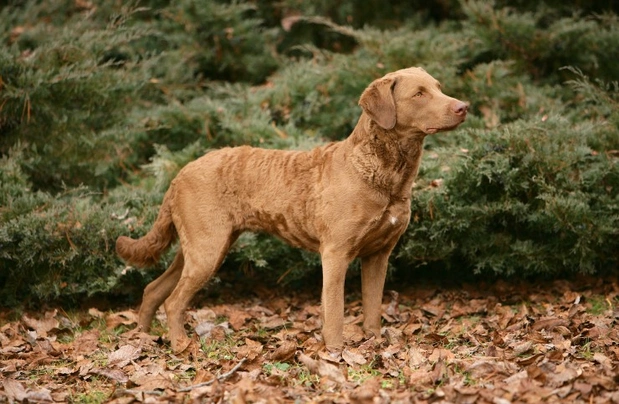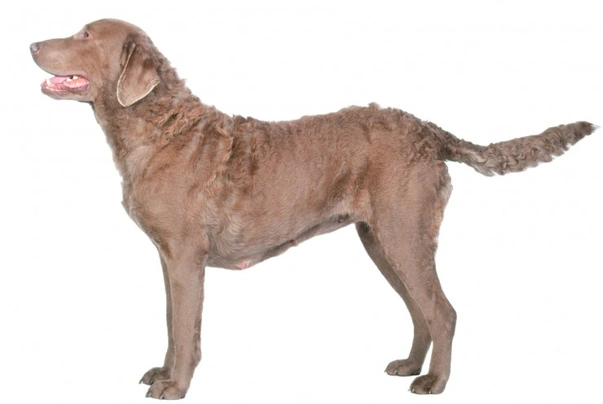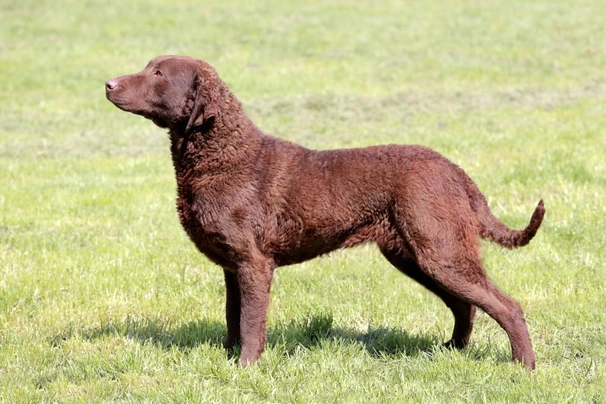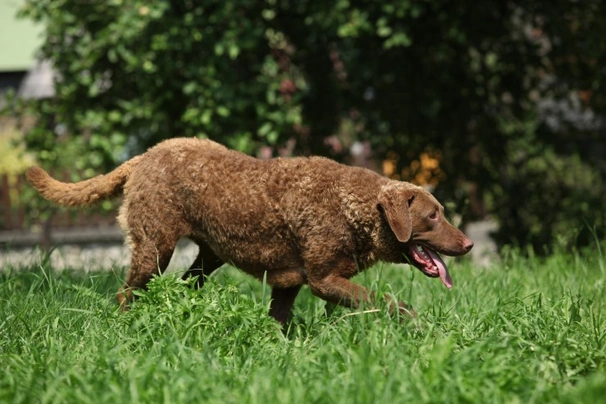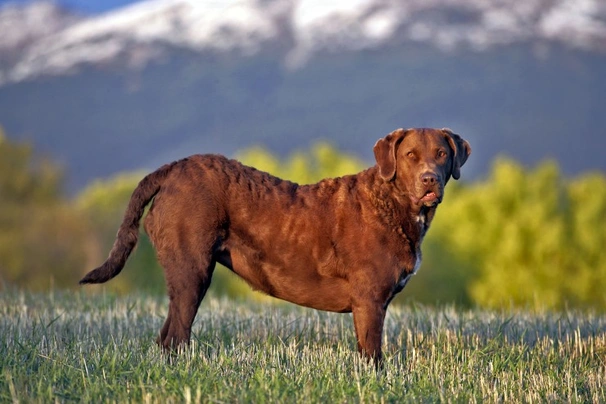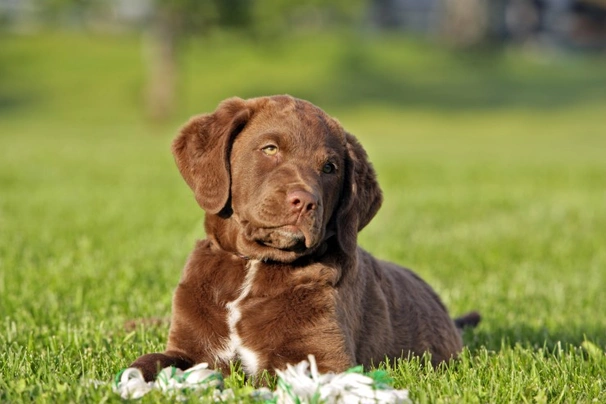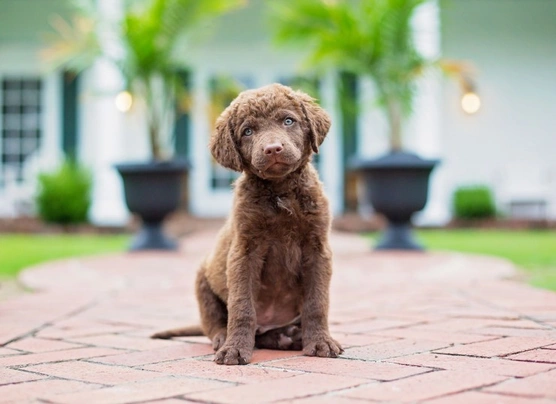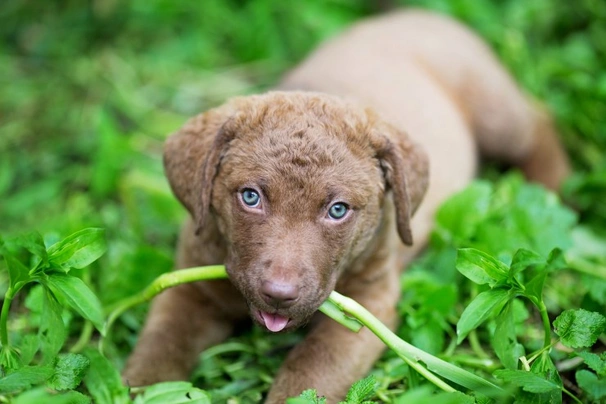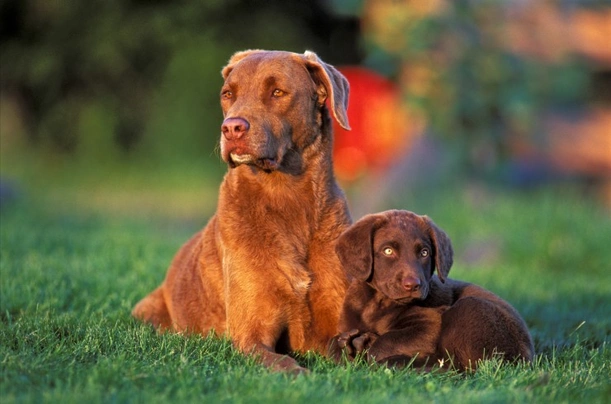Chesapeake Bay Retriever
Pros
Cons
Introduction of the Chesapeake Bay Retriever
The Chesapeake Bay Retriever boasts having a unique and distinct coat which means these dogs really do stand out in a crowd. They are large compact gundogs with an interesting ancestry. They are high energy and therefore best suited to living with owners who lead busy outdoor lives and in households where one member of the family usually stays at home when everyone else is out so that dogs are never left to their own devices for long periods of time.
They are a great choice for families with children because Chesapeakes adore being around kids and seem to have an affinity with them. However playtime can be a little boisterous which means younger children and toddlers should always be supervised when they are around dogs. Chesapeake Bay Retrievers are not the best choice for first time dog owners because they must be socialised handled and trained by people familiar with the needs of such an intelligent high-energy dog.
History of the Chesapeake Bay Retriever
The Chesapeake Bay Retriever's origins and history are quite interesting. It is thought the breed came about when two puppies were rescued from a shipwreck off the coast of Maryland some 200 years ago. These puppies were very similar to Newfoundland type dogs and it was found they adored being in water. As such they were bred to local retriever type dogs and it's thought the Curly Coat was one of the breeds used to develop the Chesapeake Bay Retriever.
One of the puppies rescued was a red dog called Sailor and he ended up being owned by Governor Lloyd who bred him to other dogs which produced excellent puppies that went on to be very well-known. The other puppy was a black female called Canton and she went on to be owned by a doctor by the name of James Stewart of Sparrow Point. She also went on to be well-known for her abilities and her offspring. Both dogs were bred to other dogs that belonged to Carrol Island Kennels as well as other kennels that existed at the time. They produced the Chesapeake Bay Retrievers we see today.
It is thought that other dogs used to create the Chessie included Flat coated and Curly Coated Retrievers Irish Water Spaniels and Coonhounds. The result was a gundog with an extraordinarily water-resistant coat that boasted an oily and thick texture which offered these dogs tremendous protection from the elements and cold waters they were to work in.
A breed standard was established for the Chesapeake Bay in 1885 and the American Kennel Club recognised these dogs as a breed in 1933. The first Chessies arrived in the UK in 1933 and by the seventies the Chesapeake Bay Retriever was already a popular gundog breed. Today these attractive and lively dogs are still popular in the field but they have also become a popular choice as both companion dogs and family pets thanks to their affectionate loyal although sometimes independent natures and the fact they have real affinity with children of all ages.
Interesting facts about the breed
- Is the Chesapeake Bay Retriever a vulnerable breed? No they are one of the most popular breeds in the States and are gaining popularity in the UK although finding puppies can prove challenging and they tend to be expensive too
- Chessies are known to “smile” when they are happy baring their teeth in a unique doggy-type grin
- They have webbed feet which means they are excellent swimmers
- They are quite independent thinkers by nature and like to understand what is being asked of them which many people mistake for stubbornness which is not the case at all
- Chessies excel at working trials agility and obedience with some dogs being used a bomb detection dogs
Appearance of the Chesapeake Bay Retriever
Height at the withers: Males 61 - 66 cm Females 56 - 64 cm
Average weight: Males 34 - 45 kg Females 30 - 40 kg
Chesapeakes are powerful and muscular dogs that boast having a very distinctive coat and they also have webbed feet. There is also quite a noticeable difference in the appearance of male and females Bays. Another very distinct feature is their broad head which has a medium stop and which is ever so slightly pointed. Their lips although thin do not hang and Bays have well developed nostrils. The colour of their nose and lips depends on the colour of a dog's coat.
Their eyes are medium in size and always very clear being either an amber or yellow colour and they are nicely set wide apart on a dog's face. Ears are quite small and set well up on a dog's head. They have moderate leathers which Bays carry close to their cheeks. These dogs have a strong jaw with a perfect scissor bite where their upper teeth neatly overlap their lower ones.
Necks are moderately long but muscular and strong tapering down from a dog's head to their shoulders. Forequarters are well-boned and nicely muscled being well laid back and powerful. Their front legs are straight and strong. A Bay's body is moderately long with dogs having well sprung ribs. Chests are well developed broad and quite deep. Their toplines are level but a dog's hindquarters are a little higher than at the withers. Flanks can be slightly tucked up.
Hindquarters are well muscled powerful and strong to match a dog's forequarters. Back legs are nicely developed and strong. Feet are very hare-like and webbed being quite large and dogs have well rounded close toes which makes them powerful swimmers. Their tails are moderately long and can be either slightly curved or straight. They are heavier at the root and dogs carry them level or a little higher than their toplines.
When it comes to their coat the Chesapeake Bay Retriever boasts having a very distinct coat which consists of a harsh oily outer coat and a fine denser and woolly undercoat which covers their entire body which is extremely weather-resistant. The hair on a dog's neck shoulders their backs and their loins is wavy. Dogs can have a small amount of feathering on their tails. Accept breed colours for Kennel Club registration are as follows:
- Ash
- Brown
- Dark Brown
- Deadgrass
- Light Brown
- Sedge
It is worth noting that the accepted breed colours for Kennel Club registration can differ from those set out in the breed standard.
Gait/movement
When a Chesapeake Bay Retriever moves they do so with a powerful smooth free and strong effortless action. As they get faster their feet converge.
Faults
The Kennel Club frowns on any exaggerations or departures from the breed standard and would judge the faults on how much they affect a dog's overall health and wellbeing as well as their ability to perform.
Males should have both testicles fully descended into their scrotums and it is worth noting that a dog can be a little lighter or heavier as well as slightly taller or shorter than set out in the Kennel Club breed standard which is only given as a guideline.
Temperament of the Chesapeake Bay Retriever
Chesapeake Bay Retrievers are known to be affectionate and loyal by nature and they boast having a natural affinity with children which makes them a great choice as family pets. However they do boast being independent thinkers and protective by nature but because they mature quite late which is typically around the time they are 3 years old the Chessie does not get overly protective until they are about 18 months old. It's important for their training to start as early as possible to curb any unwanted behaviours which includes being too protective. It is also important to note that Chessies like to understand what is being asked of them which many people confuse with “stubbornness” which it is not.
These dogs love being around water and in the great outdoors. They are not the sort of dog that would suit living in an apartment with people who lead more sedentary indoor lives. They would however thrive living in the country with people who boast very large back gardens and who enjoy spending as much of their free time as possible in the great outdoors with a canine companion.
Although friendly affectionate and highly intelligent the Chessie is not the best choice for first time owners because they need so much more in the way of exercise and mental stimulation for them to be truly happy well-rounded dogs. If they are not given the right amount these dogs can quickly develop some unwanted behavioural issues that can be hard to correct later.
Are they a good choice for first time owners?
Chessies are not the best choice for first time dog owners because they need to be socialised handled and trained by people who are familiar with the needs of such a highly intelligent and high-energy dog. They must know their place in the pack and who is alpha dog in a household to prevent them from showing a more dominant side to their natures.
What about prey drive?
Chesapeake Bay Retrievers have a high prey drive which is something that is deeply embedded in their psyche even when they are in a home environment. As such care should always be taken as to where and when a dog can run off the lead more especially when there is wildlife and/or livestock close by.
What about playfulness?
Chessies have a very playful side to their natures and love to entertain and be entertained. When well trained they excel at all sorts of canine sports which includes obedience and agility to name but two activities they are known to enjoy.
What about adaptability?
Chesapeakes are better suited to people who live in the country and who spend a lot of their time in the great outdoors with an intelligent energetic canine companion with a lot of stamina at their side.
What about separation anxiety?
Chessies form strong ties with their families and are never very happy when they find themselves left on their own for longer periods of time. They are better suited to people who either work from home or in households where one person stays at home when everyone else is out so they are never alone for any length of time which could see a dog suffering from separation anxiety. This can lead to them being destructive around the home which is a dog's way of relieving any stress they are feeling and a way to keep themselves entertained.
What about excessive barking?
Chesapeakes are not known to be “barkers” and will only generally voice an opinion when they want something or to alert an owner to something they don’t like that’s going on in their environment. In short Chessies only tend to bark when they think it is necessary which is why they make such good watchdogs. With this said rarely would a Chessie show any sort of aggressive behaviour preferring to keep their distance and bark.
Do Chesapeake Bay Retrievers like water?
It would be hard to keep a Chessie out of the water no matter what the weather because swimming and getting their feet wet is something they thoroughly enjoy and having webbed feet they are excellent swimmers. However care should always be taken when walking a Chesapeake off the lead anywhere near more dangerous watercourses just in case a dog decides to leap in and then needs rescuing because they cannot get out of the water on their own.
Are Chesapeake Bay Retrievers good watchdogs?
Chessies are natural watchdogs and always quick off the mark when it comes to letting an owner know when something is amiss in their environment. They are very protective of their owners and their property although by no means are they good “guard dogs”.
Intelligence / Trainability of the Chesapeake Bay Retriever
The Chesapeake Bay Retriever is known to be a very intelligent dog but they are also known to have a mind of their own and “free thinking” which can be mistaken for stubbornness which are previously mentioned it is not. Chessies like to understand a command before reacting but once they do understand they are always willing and eager to obey. This is one of the reasons why they are not the best choice for novice dog owners. With this said their training must start early and it needs to be consistent throughout a dog’s life. If they are not handled correctly from the word go they can start to show a more dominant side to their nature and therefore much harder to handle.
Like other puppies Chessie puppies are incredibly cute which means it is all too easy to spoil them when they first arrive in their new homes. However once a puppy is nicely settled owners must start out as they mean to go on by teaching a puppy the rules and boundaries so they understand what is expected of them. It also helps establish a pecking order and who is the alpha dog in a household. The first commands a Chessie puppy should be taught are as follows:
- Come
- Sit
- Stay
- Heel
- Quiet
- Leave it
- Down
- Bed
Children and other
Chessies are known to be calm and level-headed although a tad reserved as compared to a Lab or Golden Retriever and as such they get on well with children of all ages. With this said any interaction between children and a dog should be well supervised by an adult to make sure playtime does not get too boisterous which could end up with someone getting frightened or hurt.
Providing a Chessie has grown up with cats and other pets in a household they are generally very good around them. However this is not to say they won’t chase cats and other animals they don’t know. They can be difficult around other dogs which is why early socialisation is a must for them to grow up to be mature well-rounded characters that accept being around other dogs they don’t already know.
.
Health of the Chesapeake Bay Retriever
The average life expectancy of a Chesapeake Bay Retriever is between 10 and 13 years when properly cared for and fed an appropriate good quality diet to suit their ages.
Like so many other breeds the Chessie is known to suffer from a few hereditary health issues which are worth knowing about if you are planning share your home with one of these active and good-looking dogs. The conditions that seem to affect the breed the most include the following:
- Progressive retinal atrophy (PRA) - test available through BVA/KC eye scheme
- Hereditary cataracts (HD) – test available through the BVA/KC eye scheme
- Degenerative Myelopathy (DM) - test available through BVA/KC scheme
- Hip dysplasia - DNA test available through the BVA/KC hip scoring scheme
- Elbow dysplasia – dogs should be tested through the BVA/KC elbow testing scheme
- Exercise induced collapse (EIC) – dogs should be DNA tested
- Cranial cruciate ligament rupture
- Entropion(Eyelids Folding Inwards )
- Umbilical hernia
- Haemolymphatic
- Von Willebrand’s disease
- Cancer – melanoma (skin)
- Epilepsy
- Shoulder osteochondrosis – mainly male dogs
- Paniosteitis
- Ear Infections
- Bloat/gastric torsion
It is worth noting that the average COI for the breed currently stands at7.4%
What about vaccinations?
Chessie puppies would have been given their initial vaccinations before being sold but it is up to their new owners to make sure they have their follow-up shots in a timely manner with the vaccination schedule for puppies being as follows:
- 10 -12 weeks old bearing in mind that a puppy would not have full protection straight away but would be fully protected 2 weeks after they have had their second vaccination
There has been a lot of discussion about the need for dogs to have boosters. As such it's best to talk to a vet before making a final decision on whether a dog should continue to have annual vaccinations which are known as boosters.
What about spaying and neutering?
A lot of vets these days recommend waiting until dogs are slightly older before spaying and neutering them which means they are more mature before undergoing the procedures. As such they advise neutering males and spaying females when they are between the ages of 6 to 9 months old and sometimes even when a dog is 12 months.
Other vets recommend spaying and neutering dogs when they are 6 months old but never any earlier unless for medical reasons. With this said many breeds are different and it is always advisable to discuss things with a vet and then follow their advice on when a dog should be spayed or neutered.
What about obesity problems?
Like other breeds some Chessies gain weight after they have been spayed or neutered and it's important to keep an eye on a dog's waistline just in case they do. If a dog starts to put on weight it's important to adjust their daily calorie intake and to up the amount of exercise they are given. Older dogs too are more prone to gaining weight and again it's essential they be fed and exercised accordingly because obesity can shorten a dog's life by several years. The reason being that it puts a lot of extra strain on a dog's internal organs including the heart which could prove fatal.
What about allergies?
Some Chessies are prone to suffering from allergies and ear infections and it's important for a dog to see a vet sooner rather than later if one flares up. Allergies can be notoriously hard to clear up and finding the triggers can be challenging. It is very important to thoroughly dry off a Chessie once they’ve been in water paying special attention to their ears. With this said a vet would be able to make a dog with an allergy more comfortable while they try to find out the triggers which could include the following_:_
- Certain dog foods that contain high levels of grains and other cereal-type fillers
- Airborne pollens
- Dust mites
- Environment
- Flea and tick bites
- Chemicals found in everyday household cleaning products
Participating in health schemes
All responsible Chesapeake Bay Retriever breeders would ensure that their stud dogs are tested for known hereditary and congenital health issues known to affect the breed by using the following schemes:
- BVA/KC Hip Dysplasia Scheme
- BVA/KC/ISDS Eye Scheme
- DNA test - prcd-PRA
- DNA test – DM
- Exercise induced collapse (EIC)
- Ectodermal dysplasia
What about breed specific breeding restrictions?
Apart from the standard breeding restrictions for all Kennel Club recognised breeds there are no other breed specific breeding restrictions in place for the Chesapeake Bay Retriever.
What about Assured Breeder Requirements?
It is mandatory for all Assured Kennel Club Breeders to use the following tests on their dogs and all other breeders are strongly advised to follow suit:
The Kennel Club also strongly recommends that all breeders use the following schemes on their dogs:
Caring for the Chesapeake Bay Retriever
As with any other breed Chessies need to be groomed on a regular basis to make sure their coats and skin are kept in top condition. They also need to be given regular daily exercise to ensure they remain fit and healthy. On top of this dogs need to be fed good quality food that meets all their nutritional needs throughout their lives.
Caring for a Chesapeake Bay Retriever puppy
Chessie puppies are boisterous and full of life which means it's essential for homes and gardens to be puppy-proofed well in advance of their arrival. A responsible breeder would have well socialised their puppies which always leads to more outgoing confident and friendly dogs right from the word go. With this said any puppy is going to feel vulnerable when they leave their mother and littermates which must be taken into account. The longer a puppy can remain with their mother the better although it should never be for too long either.
It's best to pick a puppy up when people are going to be around for the first week or so which is the time needed for a puppy to settle in. Puppy-proofing the home and garden means putting away any tools and other implements that a boisterous puppy might injure themselves on. Electric wires and cables must be put out of their reach because puppies love chewing on things. Toxic plants should be removed from flowerbeds and the home too.
Puppies need to sleep a lot to grow and develop as they should which means setting up a quiet area that's not too out of the way means they can retreat to it when they want to nap and it's important not to disturb them when they are sleeping. It's also a good idea to keep "playtime" nice and calm inside the house and to have a more active "playtime" outside in the garden which means puppies quickly learn to be less boisterous when they are inside.
The documentation a breeder provides for a puppy must have all the details of their worming date and the product used as well as the information relating to their microchip. It is essential for puppies to be wormed again keeping to a schedule which is as follows:
- Puppies should be wormed at 6 months old
- They need to be wormed again when they are 8 months old
- Puppies should be wormed when they are 10 months old
- They need to be wormed when they are 12 months old
Things you'll need for your puppy
There are certain items that new owners need to already have in the home prior to bringing a new puppy home. It's often a good idea to restrict how much space a puppy plays in more especially when you can't keep an eye on what they get up to bearing in mind that puppies are often quite boisterous which means investing in puppy gates or a large enough playpen that allows a puppy the room to express themselves while keeping them safe too. The items needed are therefore as follows:
- Good quality puppy or baby gates to fit on doors
- A good well-made playpen that's large enough for a puppy to play in so they can really express themselves as puppies like to do
- Lots of well-made toys which must include good quality chews suitable for puppies to gnaw on bearing in mind that a puppy will start teething anything from when they are 3 to 8 months old
- Good quality feed and water bowls which ideally should be ceramic rather than plastic or metal
- A grooming glove
- A slicker brush or soft bristle brush
- Dog specific toothpaste and a toothbrush
- Scissors with rounded ends
- Nail clippers
- Puppy shampoo and conditioner which must be specifically formulated for use on dogs
- A well-made dog collar or harness
- A couple of strong dog leads
- A well-made dog bed that's not too small or too big
- A well-made dog crate for use in the car and in the home that's large enough for a puppy to move around in
- Baby blankets to put in your puppy's crate and in their beds for when they want to nap or go to sleep at night
Keeping the noise down
All puppies are sensitive to noise including Chessie puppies bearing in mind that they don’t respond well to raised voices and harsh handling. It's important to keep the noise levels down when a new puppy arrives in the home. TVs and music should not be played too loud which could end up stressing a small puppy out making them withdrawn timid and shy.
Keeping vet appointments
As previously mentioned Chessie puppies would have been given their first vaccinations by the breeders but they must have their follow up shots which is up to their new owners to organise. The vaccination schedule for puppies is as follows:
- 10 -12 weeks old bearing in mind that a puppy would not have full protection straight away but would only be fully protected 2 weeks after they have had their second vaccination
When it comes to boosters it's best to discuss these with a vet because there is a lot of debate about whether a dog really needs them after a certain time. However if a dog ever needed to go into kennels their vaccinations would need to be fully up to date.
What about older Chesapeake Bay Retrievers when they reach their senior years?
Older Chessie need lots of special care because as they reach their golden years they are more at risk of developing certain health concerns. Physically a dog's muzzle may start to go grey but there will be other noticeable changes too which includes the following:
- Coats become coarser
- A loss of muscle tone
- Chessies can either become overweight or underweight
- They have reduced strength and stamina
- Older dogs have difficulty regulating their body temperature
- They often develop arthritis
- Immune systems do not work as efficiently as they once did which means dogs are more susceptible to infections
- Older dogs change mentally too which means their response time tends to be slower as such they develop the following:
- They respond less to external stimuli due to impaired vision or hearing
- They tend to be a little pickier about their food
- They have a lower pain threshold
- Become intolerant of any change
- Often an older dog can feel disorientated
Living with a Chesapeake Bay Retriever in their golden years means taking on a few more responsibilities but these are easily managed and should include looking at their diet the amount of exercise they are given how often their dog beds need changing and keeping an eye on the condition of their teeth.
Older Chessies need to be fed a good quality diet that meets their needs at this stage of their lives all the while keeping a close eye on a dog's weight. A rough feeding guide for older dogs is as follows bearing in mind they should be fed highly digestible food that does not contain any additives:
- Protein content should be anything from 14 – 21%
- Fat content should be less than 10%
- Fibre content should be less than 4%
- Calcium content should be 0.5 – 0.8%
- Phosphorous content should be 0.4 – 0.7%
- Sodium content should be 0.2 – 0.4%
Older Chessies don't need to be given the same amount of daily exercise as a younger dog but they still need the right amount of physical activity to maintain muscle tone and to prevent a dog from putting on too much weight. All dogs need access to fresh clean water and this is especially true of older dogs when they reach their golden years because they are more at risk of developing kidney disorders.
Grooming of the Chesapeake Bay Retriever
Chesapeake Bay Retrievers have medium length coats that consist of tight curls that feel crisp to the touch and it covers their entire body but not their muzzles or faces. They do not have an undercoat which means they are not heavy shedders as such they are not high maintenance in the grooming department. The structure of their coats makes them incredibly water resistant which means that water and dirt simply rolls off leaving a dog's coat clean. A twice weekly brush when a Chessie is moulting is all it takes to keep their coats looking tidy and a dog's skin in good condition.
It's also important to check a dog's ears on a regular basis and to clean them when necessary. If too much wax builds up in a dog's ears it can lead to a painful infection which can be hard to clear up. In short prevention is often easier than cure when it comes to ear infections.
Exercise of the Chesapeake Bay Retriever
Chessies are high energy dogs and they need to be given a minimum of 2 hour's exercise every day. A shorter walk in the morning would be okay but a much longer and more interesting one in the afternoon is a must to keep these dogs happy and healthy. They also benefit from being allowed to roam around a back garden as often as they can but the fencing must be very secure to keep these dogs in.
Because they are such intelligent dogs Chessies also need to be given a tremendous amount of mental stimulation to prevent boredom from setting in. A bored Chesapeake will find ways to amuse themselves which could result in dogs developing some unwanted behavioural problems and becoming unruly therefore harder to manage. These dogs excel at all sorts of canine sporting activities which includes obedience and agility because they boast incredible endurance and stamina. They also love being in water so as previously touched upon care must be taken when walking one of them anywhere near dangerous water courses.
With this said young Chessie puppies should not be given too much exercise because their joints and bones are still growing and too much pressure on them could result in causing a dog a few problems later in their lives. They should not be allowed to jump up or off furniture nor should they be allowed to run up and down the stairs because this puts too much pressure on their still growing joints and limbs.
Feeding of the Chesapeake Bay Retriever
If you get a Chesapeake Bay Retriever puppy from a breeder they would give you a feeding schedule and it's important to stick to the same routine feeding the same puppy food to avoid any tummy upsets. You can change a puppy's diet but this needs to be done very gradually always making sure they don't develop any digestive upsets and if they do it's best to put them back on their original diet and to discuss things with the vet before attempting to change it again.
Older dogs are not known to be fussy or finicky eaters but this does not mean you can feed them a lower quality diet. It's best to feed a mature dog twice a day once in the morning and then again in the evening making sure it's good quality food that meets all their nutritional requirements. It's also important that dogs be given the right amount of exercise so they burn off any excess calories or they might gain too much weight which can lead to all sorts of health issues. Obesity can shorten a dog's life by several years so it's important to keep an eye on their waistline from the word go.
Because Chessies are prone to suffer from bloat (gastric torsion) it is really important that they be fed twice a day instead of giving them just one larger meal a day. It's also a good idea to invest in a stand to place their feed bowl which makes it easier for these large dogs to eat comfortably without having to stretch their necks down low to reach their food. You should never exercise a dog just before or just after they have eaten either because this puts them more a risk of suffering from bloat.
Feeding guide for a Chesapeake Bay Retriever puppy
Puppies need to be fed a highly nutritious good quality diet for them to develop and grow as they should. As a rough guide a Chessie puppy should be fed the following amounts every day making sure their meals are evenly spread out throughout the day and it's best to feed them 3 or 4 times a day:
- 2 months old - 276g to 300g depending on puppy's build
- 3 months old - 355g to 402g depending on puppy's build
- 4 months old - 390g to 435g depending on puppy's build
- 5 months old - 444g to 485g depending on puppy's build
- 6 months old - 495g to 567g depending on puppy's build
- 7 months old - 496g to 569g depending on puppy's build
- 8 months old - 461g to 534g depending on puppy's build
- 9 months old - 430g to 501g depending on puppy's build
- 10 months old - 392g to 468g depending on puppy's build
- 11 months old - 355g to 439g depending on puppy's build
- 12 months old - 363g to 402g depending on puppy's build
- 13 months old - 360g to 399g depending on puppy's build
- 14 months old - 357g to 395g depending on puppy's build
Once a puppy is 15 months old they can be fed adult dog food.
Feeding guide for an adult Chesapeake Bay Retriever
Once fully mature an adult Chessie should be fed a good quality diet to ensure their continued good health. As a rough guide an adult Chesapeake Bay Retriever can be fed the following amounts every day:
- Dogs weighing 40 kg can be fed g to g depending on activity
- Dogs weighing 45 kg can be fed g to g depending on activity
- Dogs weighing 30 kg can be fed 352g to 463g depending on activity
- Dogs weighing 40 kg can be fed 381g to 501g depending on activity
- Dogs weighing 45 kg can be fed 392g to 491g depending on activity
Chesapeake Bay Retriever price
If you are looking to buy a Chesapeake Bay Retriever you may have to go on a waiting list because not many puppies are registered with The Kennel Club every year and you would need to pay anything from £850 upwards for a well-bred pedigree puppy. The cost of insuring a male 3-year-old Chessie in northern England would be £23.87 a month for basic cover but for a lifetime policy this would set you back £49.45 a month (quote as of March 2018). When insurance companies calculate a pet's premium they factor in several things which includes where you live in the UK and a dog's age and whether they have been neutered or spayed.
When it comes to food costs you need to buy the best quality food whether wet or dry to feed your dog throughout their lives making sure it suits the different stages of their lives. This would set you back between £50 - £60 a month. On top of this you would need to factor in veterinary costs if you want to share your home with a Chessie and this includes their initial vaccinations their annual boosters the cost of neutering or spaying your dog when the time is right and their yearly health checks all of which quickly adds up to over a £1000 a year.
As a rough guide the average cost to keep and care for a Chesapeake Bay Retriever would be between £80 to £110 a month depending on the level of insurance cover you opt to buy for your dog but this does not include the initial cost of buying a well-bred Kennel Club registered pedigree Chesapeake Bay Retriever puppy.
Buying advice
When visiting and buying any puppy or dog there are many important things to consider and questions to ask of the breeder/seller. You can read our generic puppy/dog advice here which includes making sure you see the puppy with its mother and to verify that the dog has been wormed and microchipped.
Finding well-bred Chesapeake Bay Retriever puppies can prove challenging as such they can often command a lot of money. As such with Chessies there is specific advice questions and protocols to follow when buying a puppy which are as follows:
- Beware of online scams and how to avoid them. You may see online and other adverts by scammers showing images of beautiful Chesapeake Bay Retrieverpuppies for sale at very low prices. However the sellers ask buyers for money up front before agreeing to deliver a puppy to a new home. Potential buyers should never buy a puppy unseen and should never pay a deposit or any other money online to a seller. You should always visit the pet at the sellers home to confirm they are genuine and make a note of their address.
- As previously touched upon Chesapeake Bay Retriever puppies can often command a lot of money and therefore many amateur breeders/people breed from a dam far too often so they can make a quick profit without caring for the welfare of the puppies their dam or the breed in general. Under Kennel Club rules a dam can only produce 4 litters and she must be between a certain age to do so. Anyone wishing to buy a Chessie puppy should think very carefully about who they purchase their puppy from and should always ask to see the relevant paperwork pertaining to a puppy's lineage their vaccinations and their microchipping.

